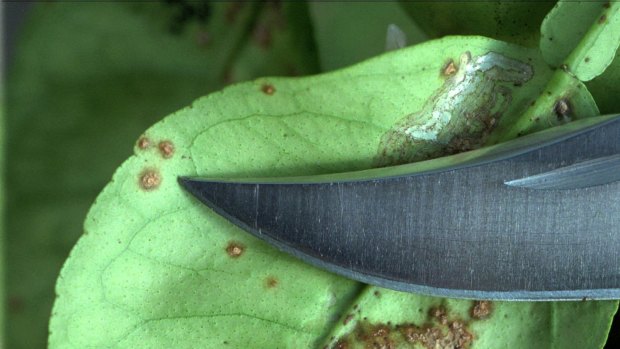By Robin Powell
In April this year an off-duty plant quarantine officer shopping in his local hardware barn in Darwin saw something for sale that he shouldn't have – a young potted citrus showing signs of citrus canker. Alarmed, he called for back-up.
Citrus canker is a bacterial disease that causes what scientists call erumpent lesions and what you and I call ugly black scaly spots, on both leaves and fruit. The fruit looks grim and often drops, though is still edible. Australia has managed to eradicate past outbreaks of the disease, but gardeners and citrus growers in the US have not been so lucky. Despite the destruction of millions of Florida's trees in an effort to eradicate the last outbreak, the hurricanes of 2004 and 2005 helped spread the pathogen so widely that control was deemed impossible. Growers have had to learn to live with it.

A leaf of a citrus plant infected with citrus canker in Sweetwater in Florida.Credit: HANS DERYK
To prevent that happening here an emergency response swung into action as soon as the sighting in Darwin was confirmed. Teams in Sydney studied the genotype and confirmed it was a strain never seen in Australia before. Those on-ground raced to trace the diseased tree's origins, tracking it to a wholesale nursery.
How the disease turned up at that nursery is unclear. The pathogen can survive 72 hours without a host so can walk into the country with an international traveller. It lives on infected trees for years and on leaf litter for months, so can also come in on imported plant material that skirts quarantine.
Plants distributed from the source of the outbreak, as well as potential host plants in a wide radius around them, were confiscated and destroyed (deep burial was the chosen method as dry season in the north prevented fires being lit). Citrus pathologists are now confident that Australia is once again clear of citrus canker. But it was close, and we were fortunate that the outbreak happened in the dry season, and not when rains and winds could have spread the bacteria.
One of Sydney's prominent citrus orchardists, Mark Engall, believes more could be done. Engall wants registration of citrus growers to prevent unsafe plant material being used in nursery production. Meanwhile, gardeners can help safeguard both our citrus industry and the backyard lemon by only buying grafted fruit trees. Certified-healthy rootstock and bud material for grafting are supplied through Auscitrus, a national not-for-profit industry-run propagation organisation.
There are other benefits from grafted plants, says Engall. "They suit different soils and conditions, give better quality fruit and live longer." Grafting also offers the opportunity of dwarfing rootstock, keeping the harvest ladder-free. Grafted trees cost more than cutting-grown plants, but the few dollars saved are inconsequential against the cost of a new disease.